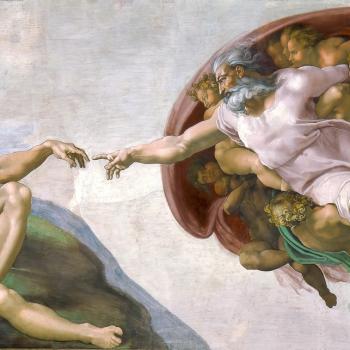[This is the third in a series of essays that examine the interconnection of karma and original sin]
- The Moral Dimension of Karma
This involves placing an overlay of a new template on the raw data of life events. Cause and effect are present from the beginning, but now the categories of ‘good’ and ‘bad’ are added to the mix. Only now do the notions of blame and praise arise. Let me give you an example. I lived for a few years in a Catholic rectory attached to St. Aloysius Church, in Palo Alto – now owned by the Ananda Community. Each evening, I would walk in a nearby park where there were groves of great redwoods and pines. One evening, I saw two little children – a boy and a girl, aged around six or seven. They were accompanied by an adult female. Suddenly, a baby squirrel fell from a tree and, instantly, the adult female ran, grabbed it and started to shake it violently. The children screamed at her to stop and I, too, ran to intervene. Too late, alas, the squirrel died in my hands and I carried it home and buried it in the rectory garden. The children were sobbing as I left.
Now, the karma question: was the behavior of the adult female good or bad? Would you say she committed a crime? Was she guilty of a sin? How would it affect your thinking if I revealed to you that the adult female was, in fact, an Alsatian dog? Obviously, her behavior would fall into dimensions 1 (basic) and 2 (practical) but not dimension 3 (moral). She had no guilt.
This moral dimension is very complex; one with which all of the great scriptural, legal and wisdom systems have wrestled – and continue to wrestle. It is, perhaps, the major theme in all great literature.
For grins, let’s go back to the book and the cat. So, whose fault was it that the feline got bopped on the noggin? Was it the cat for sleeping in a dumb spot? The person who placed the book carelessly on the shelf? The carpenter who built the shelf on a tilt? The contractor who built the house and didn’t allow for subsidence? The minor earthquake that caused the subsidence? Or the cosmic geologist who designed tectonic plates?
Within the bible itself, there are six different attempts to assign blame. First, Adam and Eve – two pre-rational humans – disobey God, whereupon they and all their future progeny are kicked out of the Garden of Eden. For one parental sin, all unborn humans are held guilty. In stage two, Moses comes up with a much better system of punishment: each year all of the Israelites would confess to Aaron, the high priest, who would then take a spotless goat, lay his hands on it and transfer the combined sins onto the animal and then hunt it off into the wilderness – no doubt to wind up as lunch for a lion (the one who no longer ate skunks!) This is the origin of the term, ‘scapegoat.’
Then comes a third stab at assigning blame. God, in his infinite mercy, is only going to mete out punishment to the third or fourth generation. Native American belief is that we humans, as we make decisions, need to factor in the effects on the next seven generations. Stage four arrives with the prophets Jeremiah (c. 600 BCE) and Ezekiel (c. 550 BCE) both of whom quote the Hebrew proverb, “the parents have eaten sour grapes and the children’s teeth are set on edge.” But, henceforth, say Jerry and Zeke, this will no longer be true; rather, only the individual who sins will be punished. No more killing a million Iraqi’s to punish Saddam Hussein.
Jesus moved the ball two more stages forward. First, he said that those who invent and impose bad laws are guiltier than those who subsequently break these bad laws. In retrospect, I wonder what was the Catholic Church thinking when it taught that anyone who eats meat on a Friday would burn in hell for all eternity! What in God’s name were they smoking?
Then, Jesus went on to teach and to exemplify the final stage in the process, which is to not judge anybody but to forgive everybody. This is not about excusing or condoning bad behavior but about letting go of anger, anxiety and resentment, as we attempt to bring about peace in our times.
In general, this moral dimension of karma asks a question which gives very complex answers. We state, in all religions, that killing another human is wrong, and yet we send troops into battle with a mandate to kill. We execute criminals; we are allowed to kill in self-defense; and we kill via abortion – according to some candidates in the political scramble for party nomination, we can even kill newborns.
- The Spiritual Dimension of Karma
Shakespeare says, “there is nothing either good or bad but thinking makes it so.” In other words, good and bad are humanly-invented categories that we overlay on the data of life. Certainly, the Alsatian dog would agree with that.
The poet Rumi said, “Out beyond ideas of wrongdoing and rightdoing there is a field. I’ll meet you there.” I believe this is the recognition of a spiritual state in which behavior is not dictated by a moral code but by dwelling in alignment with divine love. St. Augustine said, “Love God and then do as you will.” Those who are truly in love with God will instantly recognize the divinity in all others and treat them accordingly. To drive this even deeper, the apostle John also says, “Anyone who says he loves God while he hates his brother is a liar; how can you love God whom you cannot see, if you do not love your brother whom you can see?” John is giving a Christian version of the Hindu ‘namasté’ (the God in me recognizes and honors the God in you.)
This spiritual dimension of karma is best accessed by deeply pondering the following questions and then aligning with the answers: Who is God? Who am I? Who is my neighbor? And What is my mission?
- The Mystical Dimension of Karma
I believe that we are ‘response-able’ for the state of creation, not because we caused all of it but because, as self-aware fractals of Source, we volunteered to bring all of creation back into alignment with its divine essence. St. Paul says, “For the creation waits in eager expectation for the children of God to be revealed… in hope that the creation itself will be liberated from its bondage to decay and brought into the freedom and glory of the children of God. We know that the whole creation has been groaning as in the pains of childbirth right up to the present time. Not only so, but we ourselves, who have the first-fruits of the Spirit, groan inwardly as we wait eagerly for our adoption to sonship.”
Humans, as the high point of consciousness on this planet, have the ability and the task of burning off all Earth karma. This is our vocation; this is why we volunteered for incarnation. This is where Jesus is the archetype par excellence of Tikkun Olam (a Hebrew mystical teaching meaning, ‘Fixing the planet’). In one of the most extraordinary single phrases in all the scriptures, Paul says, in 2 Cor 5:21, “God made him who had no sin to be sin for us, so that in him we might become the righteousness of God.” Paul did not simply mean that a naïve Jesus who did not know what sin was, later figured it out. Rather, Paul is saying that Jesus, who was himself in total alignment with the divine essence and, therefore, sinless, absorbed the world’s darkness into his very being – like blotting paper soaking up an ink spill. Even nature herself has given us a prototype of this process: plants, which absorb our carbon dioxide waste and transform it into oxygen – the essential food for all animals. The Christ archetype is the ultimate reason for our volunteering to incarnate. If we want to be healers for a violent world, we cannot resort to violence ourselves – in thoughts, words or deeds – in the hope of ending violence. To reprise Jesus’s words, “where two or three are gathered in my name, there am I in their midst” I would say, “where two or three are gathered in love, there is Christ consciousness; and where two or three are gathered in anger, there is Chaos consciousness.”
Buddhism’s version of ‘forgive your enemies, pray for those who persecute you…’ is the practice of Tonglen which consists of a conscious breathing technique where one takes on the suffering of others with the in-breath, transforms it in the loving furnace of the heart, and, on the out-breath, gives it back as happiness to all sentient beings. And Buddhism’s version of Tikkun Olam is the bodhisattva vow to keep on reincarnating until every sentient being awakens to its true nature.
- Five Practices in Order to Become a Christ Conscious Karma Gobbler
Number one, forgive, not from your lips only but from your heart. Forgive personal insults; forgive insults to your family; forgive insults to your tribe or culture or religion or nation. Seek reconciliation.
Number two, tell yourself better stories. And stories come in four basic flavors: personal stories, tribal stories (sometimes known as ‘history’), cosmological stories and theological stories. Simply pick a different sample of data from the past; no need to make them up; just choose more carefully, more lovingly. It’s never too late to have a happy past.
Number three: try to make as many people as possible smile today; fellow motorists, people in line at the Post Office; your spouse, children, friends and colleagues. Physiologically speaking, it takes far fewer facial muscles to smile than it does to scowl. Moreover, it feels good and does good.
Number four: be as curious as a child. Aren’t you jaded from being jaded? Open your eyes a little wider; then your ears; and, finally, your heart.
Practice number five: talk to a tree; better yet, listen to a tree! You can do this vibrationally through your hands or telepathically by softening your gaze and your heart. You will find that it is quite easy to become fluent.
The future belongs to karma gobblers because they are the ones creating the future. They are the new species that will inherit the planet, just as Jesus promised. Sign up today.
[To be continued in essay #4]













